Bibliometric Analysis Reveals the Progress of PM2.5 in Health Research, Especially in Cancer Research
Abstract
1. Introduction
2. Materials and Methods
2.1. Data Source and Search Strategy
2.2. Bibliometric Analysis and Visualization
3. Results
3.1. The Trend in Global Publications
3.2. Distribution of Institutions
3.3. Analysis of Journals and Research Areas
3.4. Analysis of Authors and Publications
3.5. Co-Citation Analysis
3.6. Country Collaboration Analysis
3.7. Co-Occurrence Analysis of Keywords
4. Discussion
4.1. Journals Contribution about PM2.5 and Cancer
4.2. Authors Contribution about PM2.5 and Cancer
4.3. Cited Articles and Country Collaboration about PM2.5 and Cancer
4.4. Keyword Co-Occurrence Analysis for PM2.5 and Cancer
4.5. Keyword Co-Occurrence Analysis for PM2.5 and Cancer (Except Lung Cancer)
5. Conclusions
Author Contributions
Funding
Institutional Review Board Statement
Informed Consent Statement
Data Availability Statement
Acknowledgments
Conflicts of Interest
References
- Hunter, P. The health toll of air pollution Despite global efforts to clean up the air, outdoor and indoor air pollution still have a drastic negative effect on public health. EMBO Rep. 2020, 21, e51183. [Google Scholar] [CrossRef]
- Liang, C.S.; Duan, F.K.; He, K.B.; Ma, Y.L. Review on recent progress in observations, source identifications and countermeasures of PM2.5. Environ. Int. 2016, 86, 150–170. [Google Scholar] [CrossRef]
- Safiri, S.; Kolahi, A.A.; Naghavi, M.; Global Burden of Disease Bladder Cancer, C. Global, regional and national burden of bladder cancer and its attributable risk factors in 204 countries and territories, 1990–2019: A systematic analysis for the Global Burden of Disease study 2019. BMJ Glob. Health 2021, 6, e004128. [Google Scholar] [CrossRef]
- Pope, C.A., 3rd; Coleman, N.; Pond, Z.A.; Burnett, R.T. Fine particulate air pollution and human mortality: 25+ years of cohort studies. Environ. Res. 2020, 183, 108924. [Google Scholar] [CrossRef] [PubMed]
- Wang, N.; Mengersen, K.; Kimlin, M.; Zhou, M.; Tong, S.; Fang, L.; Wang, B.; Hu, W. Lung cancer and particulate pollution: A critical review of spatial and temporal analysis evidence. Environ. Res. 2018, 164, 585–596. [Google Scholar] [CrossRef]
- Wang, K.; Hao, Y.; Au, W.; Christiani, D.C.; Xia, Z.L. A Systematic Review and Meta-Analysis on Short-Term Particulate Matter Exposure and Chronic Obstructive Pulmonary Disease Hospitalizations in China. J. Occup. Environ. Med. 2019, 61, e112–e124. [Google Scholar] [CrossRef] [PubMed]
- Mannucci, P.M.; Harari, S.; Franchini, M. Novel evidence for a greater burden of ambient air pollution on cardiovascular disease. Haematologica 2019, 104, 2349–2357. [Google Scholar] [CrossRef]
- Thangavel, P.; Park, D.; Lee, Y.C. Recent Insights into Particulate Matter (PM2.5)-Mediated Toxicity in Humans: An Overview. Int. J. Environ. Res. Public Health 2022, 19, 7511. [Google Scholar] [CrossRef]
- Yao, Y.F.; Wang, K.; Xiang, H. Association between cognitive function and ambient particulate matters in middle-aged and elderly Chinese adults: Evidence from the China Health and Retirement Longitudinal Study (CHARLS). Sci. Total Environ. 2022, 828, 154297. [Google Scholar] [CrossRef] [PubMed]
- Shou, Y.K.; Huang, Y.L.; Zhu, X.Z.; Liu, C.Q.; Hu, Y.; Wang, H.H. A review of the possible associations between ambient PM2.5 exposures and the development of Alzheimer’s disease. Ecotox. Environ. Saf. 2019, 174, 344–352. [Google Scholar] [CrossRef]
- Coleman, N.C.; Burnett, R.T.; Higbee, J.D.; Lefler, J.S.; Merrill, R.M.; Ezzati, M.; Marshall, J.D.; Kim, S.Y.; Bechle, M.; Robinson, A.L.; et al. Cancer mortality risk, fine particulate air pollution, and smoking in a large, representative cohort of US adults. Cancer Cause Control 2020, 31, 767–776. [Google Scholar] [CrossRef] [PubMed]
- Jin, X.T.; Chen, M.L.; Li, R.J.; An, Q.; Song, L.; Zhao, Y.; Xiao, H.; Cheng, L.; Li, Z.Y. Progression and inflammation of human myeloid leukemia induced by ambient PM2.5 exposure. Arch. Toxicol. 2016, 90, 1929–1938. [Google Scholar] [CrossRef] [PubMed]
- Thompson, D.F.; Walker, C.K. A descriptive and historical review of bibliometrics with applications to medical sciences. Pharmacotherapy 2015, 35, 551–559. [Google Scholar] [CrossRef]
- Kokol, P.; Blazun Vosner, H.; Zavrsnik, J. Application of bibliometrics in medicine: A historical bibliometrics analysis. Health Info. Libr. J. 2021, 38, 125–138. [Google Scholar] [CrossRef] [PubMed]
- Chen, D.; Liu, Z.; Luo, Z.H.; Webber, M.; Chen, J. Bibliometric and visualized analysis of emergy research. Ecol. Eng. 2016, 90, 285–293. [Google Scholar] [CrossRef]
- Abramo, G.; Cicero, T.; D’Angelo, C.A. A field-standardized application of DEA to national-scale research assessment of universities. J. Informetr. 2011, 5, 618–628. [Google Scholar] [CrossRef]
- Trujillo, C.M.; Long, T.M. Document co-citation analysis to enhance transdisciplinary research. Sci. Adv. 2018, 4, e1701130. [Google Scholar] [CrossRef]
- Hirsch, J.E. An index to quantify an individual’s scientific research output. Proc. Natl. Acad. Sci. USA 2005, 102, 16569–16572. [Google Scholar] [CrossRef]
- Zhou, X.H.; Cao, Z.Y.; Ma, Y.J.; Wang, L.P.; Wu, R.D.; Wang, W.X. Concentrations, correlations and chemical species of PM2.5/PM10 based on published data in China: Potential implications for the revised particulate standard. Chemosphere 2016, 144, 518–526. [Google Scholar] [CrossRef] [PubMed]
- Zhao, C.; Wang, Y.; Su, Z.L.; Pu, W.Y.; Niu, M.Y.; Song, S.Y.; Wei, L.L.; Ding, Y.B.; Xu, L.Z.; Tian, M.; et al. Respiratory exposure to PM2.5 soluble extract disrupts mucosal barrier function and promotes the development of experimental asthma. Sci. Total Environ. 2020, 730, 139145. [Google Scholar] [CrossRef]
- Yu, Y.; Zhou, X.; Zhu, W.W.; Shi, Q.F. Socioeconomic driving factors of PM2.5 emission in Jing-Jin-Ji region, China: A generalized Divisia index approach. Environ. Sci. Pollut. R 2021, 28, 15995–16013. [Google Scholar] [CrossRef] [PubMed]
- Li, J.; Ding, T.; He, W. Socio-economic driving forces of PM2.5 emission in China: A global meta-frontier-production-theoretical decomposition analysis. Environ. Sci. Pollut. Res. Int. 2022, 29, 77565–77579. [Google Scholar] [CrossRef] [PubMed]
- Yin, P.; Brauer, M.; Cohen, A.J.; Wang, H.D.; Li, J.; Burnett, R.T.; Stanaway, J.D.; Causey, K.; Larson, S.; Godwin, W.; et al. The effect of air pollution on deaths, disease burden, and life expectancy across China and its provinces, 1990-2017: An analysis for the Global Burden of Disease Study 2017. Lancet Planet Health 2020, 4, E386–E398. [Google Scholar] [CrossRef] [PubMed]
- Erickson, A.C.; Christidis, T.; Pappin, A.; Brook, J.R.; Crouse, D.L.; Hystad, P.; Li, C.; Martin, R.V.; Meng, J.; Pinault, L.; et al. Disease assimilation: The mortality impacts of fine particulate matter on immigrants to Canada. Health Rep. 2020, 31, 14–26. [Google Scholar] [CrossRef] [PubMed]
- Raaschou-Nielsen, O.; Andersen, Z.J.; Beelen, R.; Samoli, E.; Stafoggia, M.; Weinmayr, G.; Hoffmann, B.; Fischer, P.; Nieuwenhuijsen, M.J.; Brunekreef, B.; et al. Air pollution and lung cancer incidence in 17 European cohorts: Prospective analyses from the European Study of Cohorts for Air Pollution Effects (ESCAPE). Lancet Oncol. 2013, 14, 813–822. [Google Scholar] [CrossRef] [PubMed]
- Pope, C.A.; Burnett, R.T.; Thun, M.J.; Calle, E.E.; Krewski, D.; Ito, K.; Thurston, G.D. Lung cancer, cardiopulmonary mortality, and long-term exposure to fine particulate air pollution. JAMA J. Am. Med. Assoc. 2002, 287, 1132–1141. [Google Scholar] [CrossRef]
- Cesaroni, G.; Badaloni, C.; Gariazzo, C.; Stafoggia, M.; Sozzi, R.; Davoli, M.; Forastiere, F. Long-Term Exposure to Urban Air Pollution and Mortality in a Cohort of More than a Million Adults in Rome. Environ. Health Persp. 2013, 121, 324–331. [Google Scholar] [CrossRef]
- Tahri, M.; Benchrif, A.; Bounakhla, M.; Benyaich, F.; Noack, Y. Seasonal variation and risk assessment of PM2.5 and PM2.5-10 in the ambient air of Kenitra, Morocco. Environ. Sci. Proc. Imp. 2017, 19, 1427–1436. [Google Scholar] [CrossRef]
- Kwon, H.S.; Ryu, M.H.; Carlsten, C. Ultrafine particles: Unique physicochemical properties relevant to health and disease. Exp. Mol. Med. 2020, 52, 318–328. [Google Scholar] [CrossRef]
- Zarandi, S.M.; Shahsavani, A.; Khodagholi, F.; Fakhri, Y. Concentration, sources and human health risk of heavy metals and polycyclic aromatic hydrocarbons bound PM2.5 ambient air, Tehran, Iran. Environ. Geochem. Health 2019, 41, 1473–1487. [Google Scholar] [CrossRef]
- Zhou, Q.H.; Chen, J.N.; Zhang, J.N.; Zhou, F.F.; Zhao, J.J.; Wei, X.Z.; Zheng, K.Y.; Wu, J.; Li, B.J.; Pan, B.J. Toxicity and endocrine-disrupting potential of PM2.5: Association with particulate polycyclic aromatic hydrocarbons, phthalate esters, and heavy metals. Environ. Pollut. 2022, 292, 118349. [Google Scholar] [CrossRef] [PubMed]
- Parikh, P.V.; Wei, Y.D. PAHs and PM2.5 emissions and female breast cancer incidence in metro Atlanta and rural Georgia. Int. J. Environ. Health R 2016, 26, 458–466. [Google Scholar] [CrossRef] [PubMed]
- Gabet, S.; Lemarchand, C.; Guenel, P.; Slama, R. Breast Cancer Risk in Association with Atmospheric Pollution Exposure: A Meta-Analysis of Effect Estimates Followed by a Health Impact Assessment. Environ. Health Persp. 2021, 129, 057012. [Google Scholar] [CrossRef] [PubMed]
- Wesselink, A.K.; Rosenberg, L.; Wise, L.A.; Jerrett, M.; Coogan, P.F. A prospective cohort study of ambient air pollution exposure and risk of uterine leiomyomata. Hum. Reprod. 2021, 36, 2321–2330. [Google Scholar] [CrossRef] [PubMed]
- Chuang, Y.H.; Lin, I.F.; Lao, X.Q.; Lin, C.Q.; Chan, T.C. The Association Between Renal Function Decline and the Incidence of Urothelial Carcinoma: A 16-year Retrospective Cohort Study in Taiwan. Eur. Urol. Open Sci. 2021, 27, 1–9. [Google Scholar] [CrossRef] [PubMed]
- Rhew, S.H.; Kravchenko, J.; Lyerly, H.K. Exposure to low-dose ambient fine particulate matter PM2.5 and Alzheimer’s disease, non-Alzheimer’s dementia, and Parkinson’s disease in North Carolina. PLoS ONE 2021, 16, e0253253. [Google Scholar] [CrossRef] [PubMed]
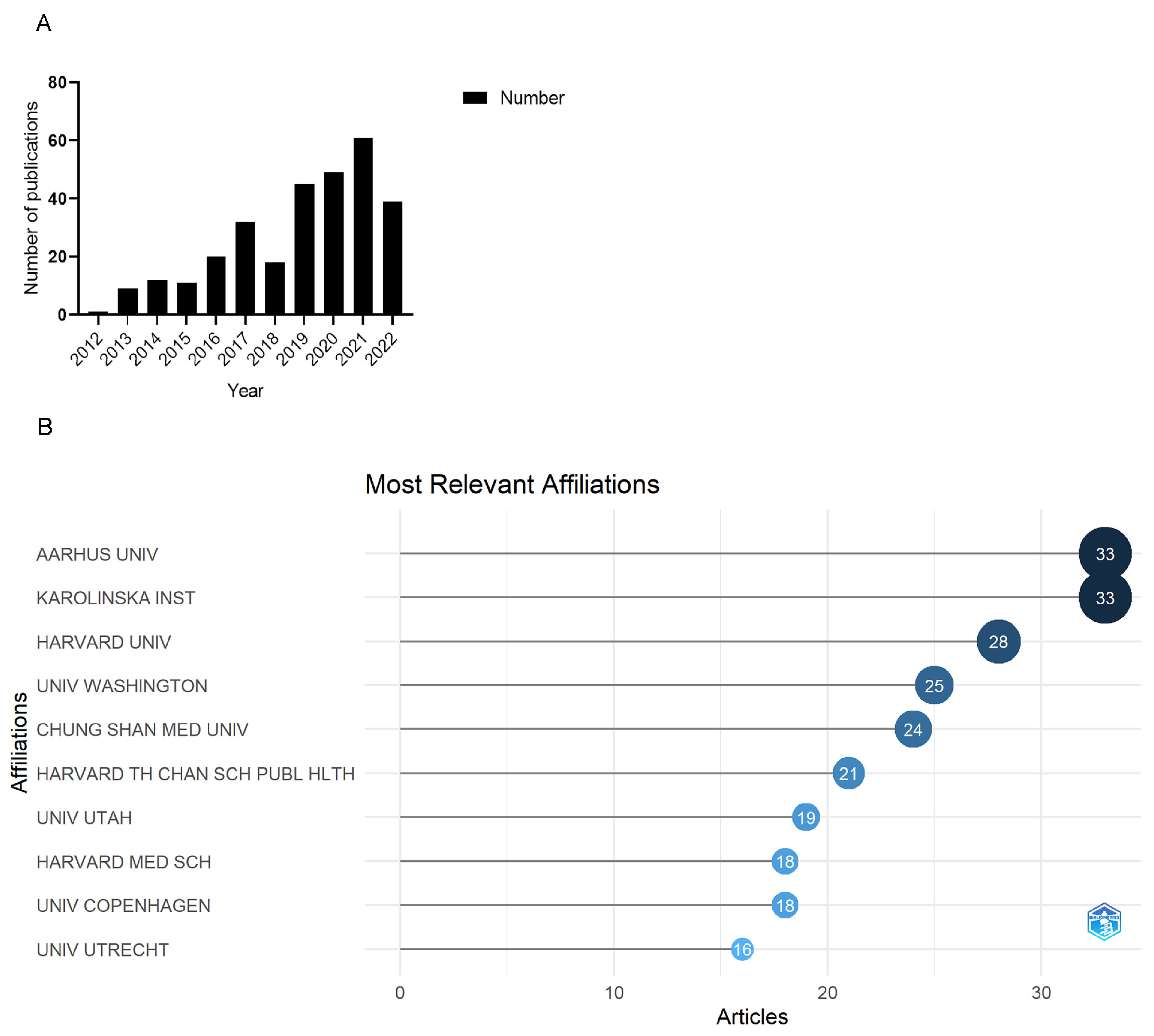
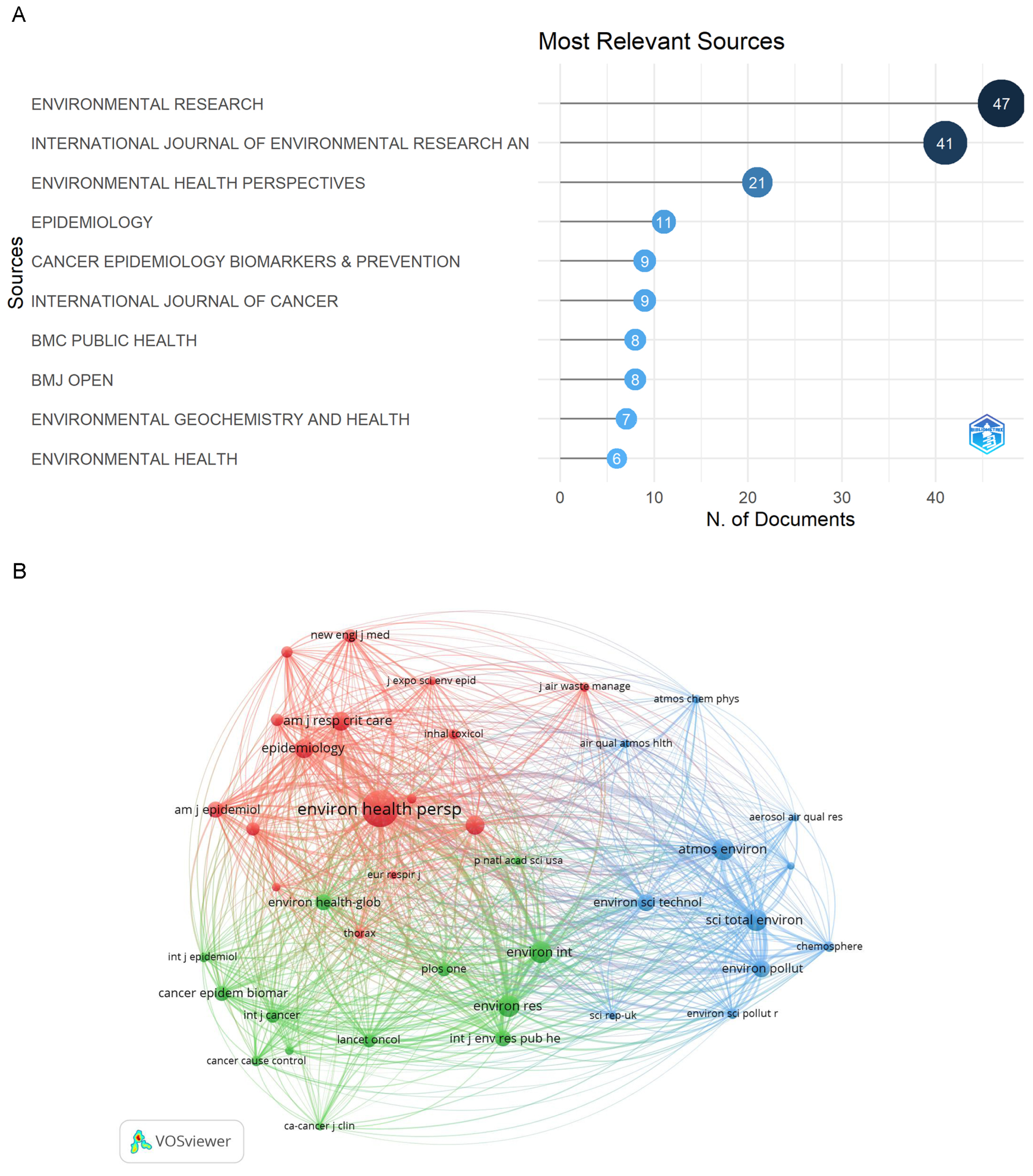
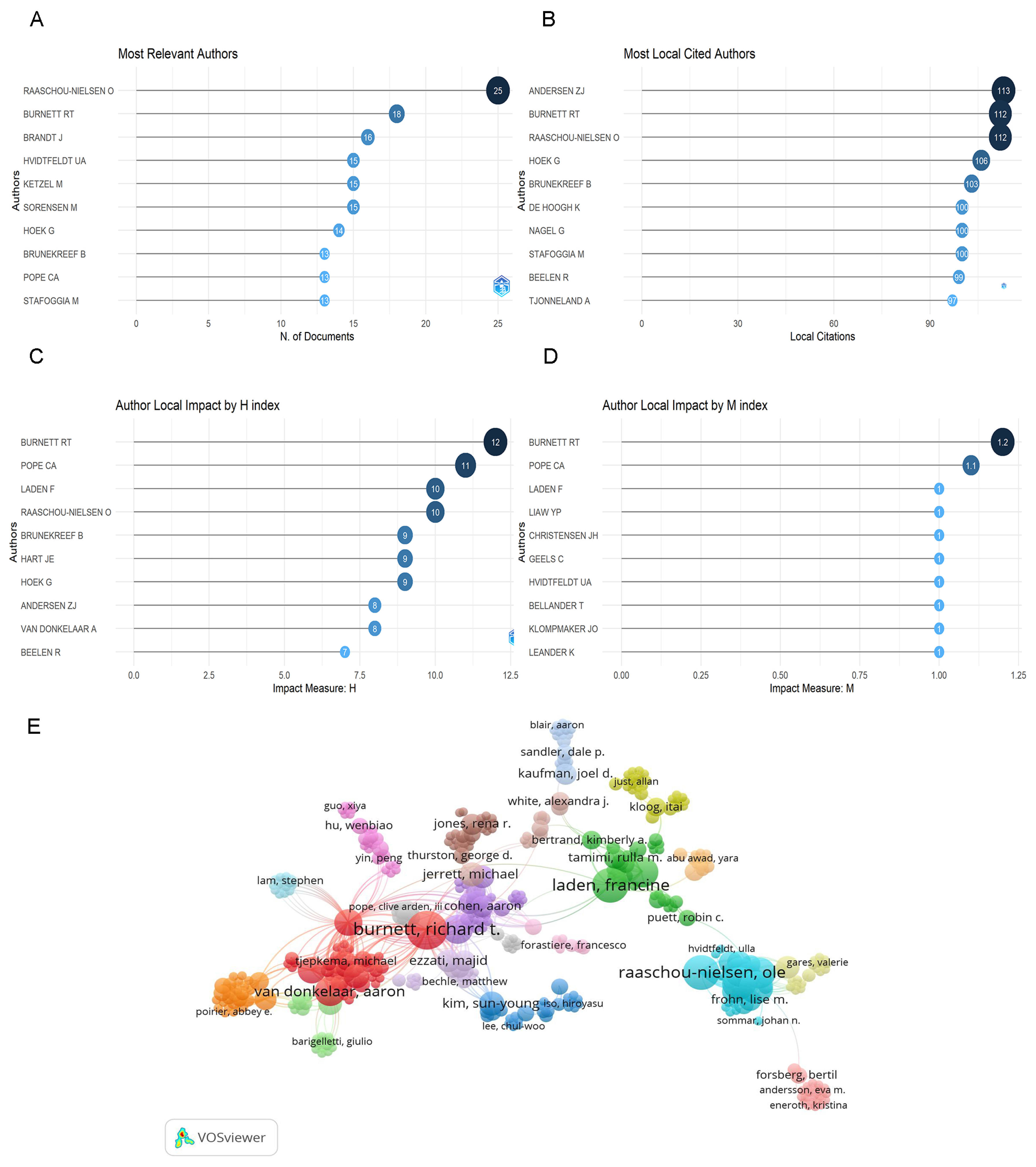
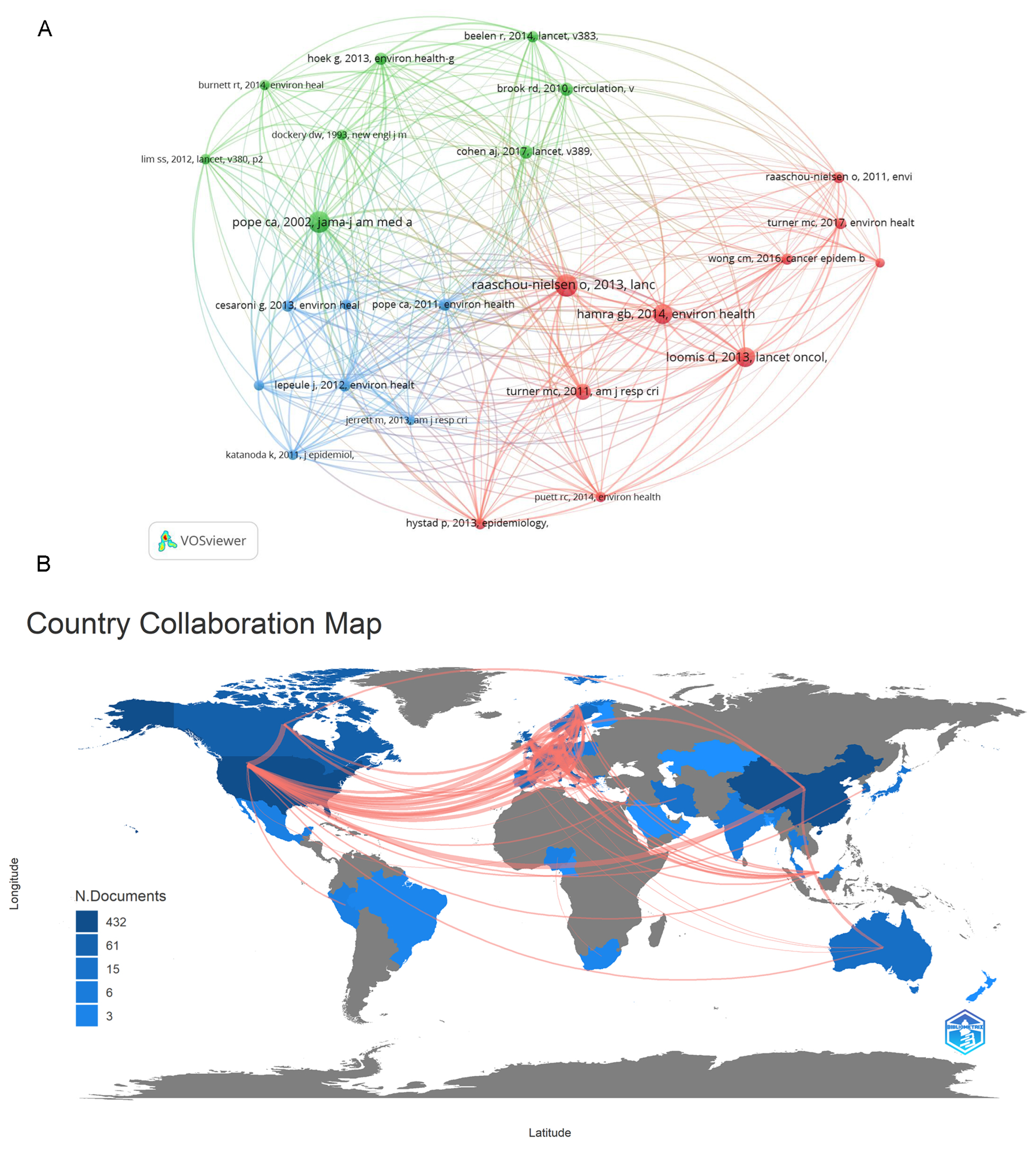
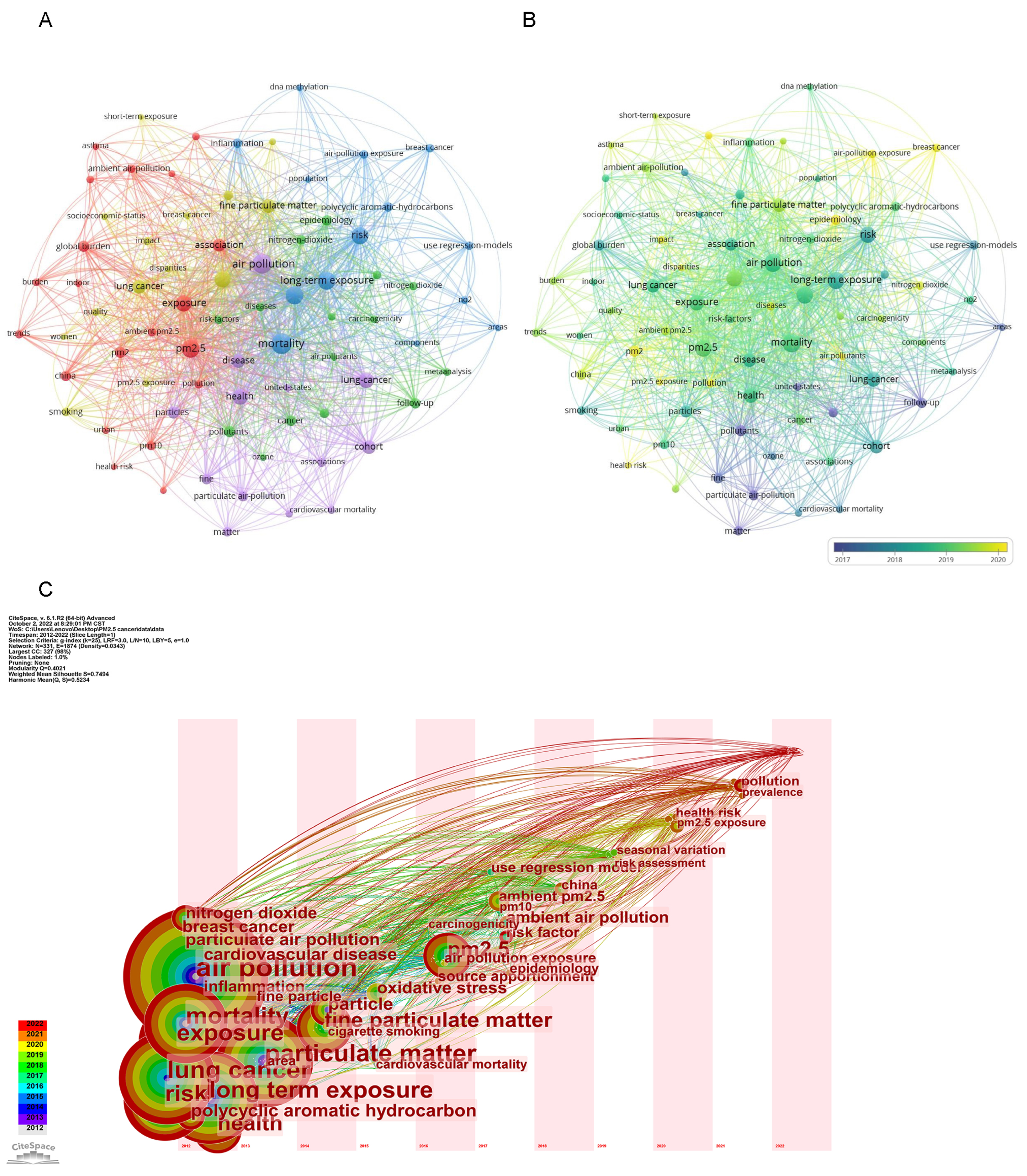
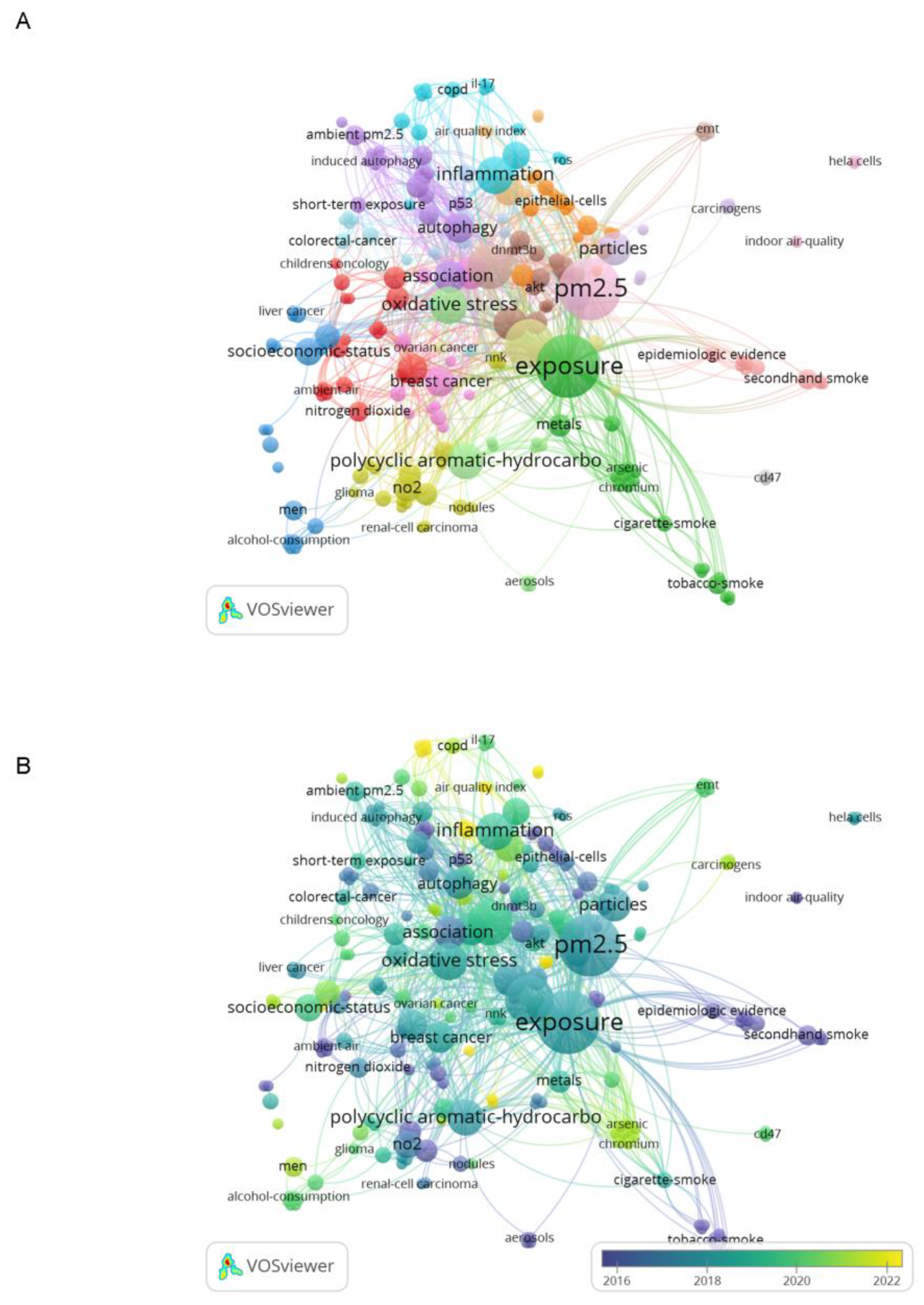
| Category | Specific Standard Requirements |
|---|---|
| Research database | Web of Science core collection |
| Citation indexes | SCI |
| Searching period | 30 September 2012 to 30 September 2022 |
| Searching keywords | (“PM2.5”) AND (“Cancer”) |
| Subject categories | Oncology/Public Environmental Occupational Health/Medicine General Internal |
| Document types | “Articles”, “Reviews”, “early access”, “proceedings paper” |
| Data extraction | Export with full records and cited references in plain text format |
| Sample size | 297 |
Disclaimer/Publisher’s Note: The statements, opinions and data contained in all publications are solely those of the individual author(s) and contributor(s) and not of MDPI and/or the editor(s). MDPI and/or the editor(s) disclaim responsibility for any injury to people or property resulting from any ideas, methods, instructions or products referred to in the content. |
© 2023 by the authors. Licensee MDPI, Basel, Switzerland. This article is an open access article distributed under the terms and conditions of the Creative Commons Attribution (CC BY) license (https://creativecommons.org/licenses/by/4.0/).
Share and Cite
Xie, Y.; Shi, K.; Yuan, Y.; Gu, M.; Zhang, S.; Wang, K.; Fu, L.; Shen, C.; Yuan, Z. Bibliometric Analysis Reveals the Progress of PM2.5 in Health Research, Especially in Cancer Research. Int. J. Environ. Res. Public Health 2023, 20, 1271. https://doi.org/10.3390/ijerph20021271
Xie Y, Shi K, Yuan Y, Gu M, Zhang S, Wang K, Fu L, Shen C, Yuan Z. Bibliometric Analysis Reveals the Progress of PM2.5 in Health Research, Especially in Cancer Research. International Journal of Environmental Research and Public Health. 2023; 20(2):1271. https://doi.org/10.3390/ijerph20021271
Chicago/Turabian StyleXie, Yaxuan, Kejian Shi, Yuncong Yuan, Meijia Gu, Shihan Zhang, Kai Wang, Liangying Fu, Chao Shen, and Zhanpeng Yuan. 2023. "Bibliometric Analysis Reveals the Progress of PM2.5 in Health Research, Especially in Cancer Research" International Journal of Environmental Research and Public Health 20, no. 2: 1271. https://doi.org/10.3390/ijerph20021271
APA StyleXie, Y., Shi, K., Yuan, Y., Gu, M., Zhang, S., Wang, K., Fu, L., Shen, C., & Yuan, Z. (2023). Bibliometric Analysis Reveals the Progress of PM2.5 in Health Research, Especially in Cancer Research. International Journal of Environmental Research and Public Health, 20(2), 1271. https://doi.org/10.3390/ijerph20021271






